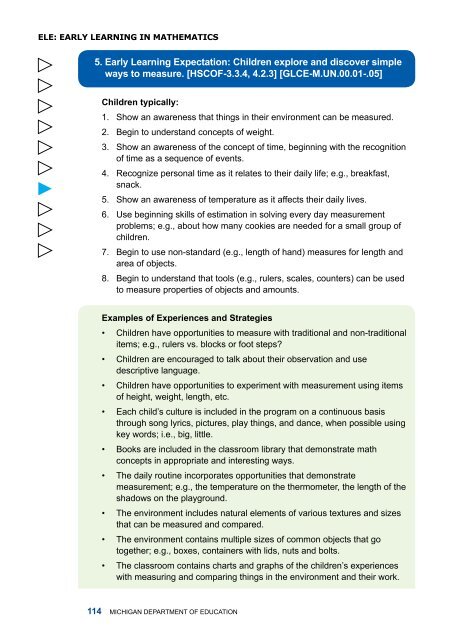Early Childhood Standards of Quality for ... - State of Michigan
Early Childhood Standards of Quality for ... - State of Michigan
Early Childhood Standards of Quality for ... - State of Michigan
You also want an ePaper? Increase the reach of your titles
YUMPU automatically turns print PDFs into web optimized ePapers that Google loves.
ELE: <strong>Early</strong> learning in mathematics5. <strong>Early</strong> Learning Expectation: Children explore and discover simpleways to measure. [HSCOF-3.3.4, 4.2.3] [GLCE-M.UN.00.01-.05]Children typically:1. Show an awareness that things in their environment can be measured.2. Begin to understand concepts <strong>of</strong> weight.3. Show an awareness <strong>of</strong> the concept <strong>of</strong> time, beginning with the recognition<strong>of</strong> time as a sequence <strong>of</strong> events.4. Recognize personal time as it relates to their daily life; e.g., breakfast,snack.5. Show an awareness <strong>of</strong> temperature as it affects their daily lives.6. Use beginning skills <strong>of</strong> estimation in solving every day measurementproblems; e.g., about how many cookies are needed <strong>for</strong> a small group <strong>of</strong>children.7. Begin to use non-standard (e.g., length <strong>of</strong> hand) measures <strong>for</strong> length andarea <strong>of</strong> objects.8. Begin to understand that tools (e.g., rulers, scales, counters) can be usedto measure properties <strong>of</strong> objects and amounts.Examples <strong>of</strong> Experiences and Strategies• Children have opportunities to measure with traditional and non-traditionalitems; e.g., rulers vs. blocks or foot steps?• Children are encouraged to talk about their observation and usedescriptive language.• Children have opportunities to experiment with measurement using items<strong>of</strong> height, weight, length, etc.• Each child’s culture is included in the program on a continuous basisthrough song lyrics, pictures, play things, and dance, when possible usingkey words; i.e., big, little.• Books are included in the classroom library that demonstrate mathconcepts in appropriate and interesting ways.• The daily routine incorporates opportunities that demonstratemeasurement; e.g., the temperature on the thermometer, the length <strong>of</strong> theshadows on the playground.• The environment includes natural elements <strong>of</strong> various textures and sizesthat can be measured and compared.• The environment contains multiple sizes <strong>of</strong> common objects that gotogether; e.g., boxes, containers with lids, nuts and bolts.• The classroom contains charts and graphs <strong>of</strong> the children’s experienceswith measuring and comparing things in the environment and their work.114 <strong>Michigan</strong> Department <strong>of</strong> Education


